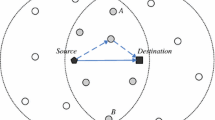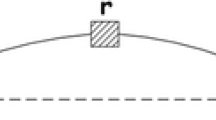Abstract
In multi-hop wireless networks, minimizing the transmission time is very important. In this paper, a high-reliability relay algorithm (HRRA) is proposed to decrease the transmission time based on the network coding in multi-rate environment. The HRRA includes the relay selection algorithm (RSA) and the block transmission algorithm (BTA). Based on the relay reliability of node, RSA chooses the neighbor with the higher link rate as the common relay node and creates more network coding opportunities at the common relay node. Thus, the network coding opportunities and the high-rate links associated with common node could both be exploited in the transmissions of BTA. Moreover, a comprehensive theoretical analysis of the transmission time of HRRA in a block is presented. Lastly, the simulation results show that HRRA can significantly reduce the transmission time compared with the shortest path algorithm and heuristic relay node selection algorithm and COPE.









Similar content being viewed by others
References
Ahlswede, R., Cai, N., Li, S., & Yeung, R. (2000). Network information flow. IEEE Transactions on Information Theory, 46(4), 1204–1216.
Li, S. Y. R., Yeung, R. W., & Cai, N. (2003). Linear network coding. IEEE Transactions on Information Theory, 49(2), 371–381.
Park, J. S., Gerla, M., Lun, D. S., & Yi, Y. (2006). Codecast: A network-coding-based ad hoc multicast protocol. IEEE Wireless Communications, 13(5), 76–81.
Katti, S., Rahul, H., Hu, W., Katabi, D., Médard, M., & Crowcroft, J. (2006). XORs in the air: Practical wireless network coding. In Proceedings of the 2006 conference on Applications, technologies, architectures, and protocols for computer communications (SIGCOMM), (pp. 243–254). ACM.
Tran, T., & Nguyen, T. (2016). Context-aware interflow network coding and scheduling in wireless networks. IEEE Transactions on Vehicular Technology, 65(11), 9299–9318.
Maheshwar, S., Li, Z., & Li, B. (2012). Bounding the coding advantage of combination network coding in undirected networks. IEEE Transactions on Information Theory, 58(2), 570–584.
Zhao, F., & Medard, M. (2010). On analyzing and improving COPE performance. In Information theory and applications workshop (ITA), (pp. 1–6). IEEE.
Lu, F., & Xu, J. (2014). Research and realization of multi-channel multi-interface wireless network coding based on guesswork. In Fifth international conference on multimedia information networking and security (pp. 239–242). IEEE.
Khan, A. S., & Chatzigeorgiou, I. (2016). Improved bounds on the decoding failure probability of network coding over multi-source multi-relay networks. IEEE Communications Letters, 20(10), 2035–2038.
Wu, Y., Chou, P. A., & Kung, S. Y. (2004). Minimum-energy multicast in mobile ad hoc networks using network coding. IEEE Transactions on Communications, 53(11), 1906–1918.
Wang, Q., Wang, Q., Xu, Y., & Guo, Q. (2010). A minimum transmission time encoding algorithm in multi-rate wireless networks. Computer Communications, 33(2), 222–226.
IEEE 802.11b. (1999). Wireless LAN medium access control (MAC) and physical layer (PHY) specifications: High-speed physical layer extension in the 2.4 GHz Band, Supplement to IEEE 802.11 Standard, Part 11.
Vassis, D., Kormentzas, G., Rouskas, A., & Maglogiannis, I. (2005). The IEEE 802.11 g standard for high data rate WLANs. IEEE Network, 19(3), 21–26.
Li, X. (2008). Hop optimization and relay node selection in multi-hop wireless ad-hoc networks. Networks for Grid Applications, 94(3–4), 161.
Wang, Q., Xu, Y., Wang, Q., & Zhan, C. (2009). Relay-based multicast routing in multirate-aware MANETs. In IEEE international conference on distributed computing systems workshops (pp. 117–122). IEEE.
Sharma, S., Shi, Y., Hou, Y. T., Sherali, H. D., Kompella, S., & Midkiff, S. F. (2012). Joint flow routing and relay node assignment in cooperative multi-hop networks. IEEE Journal on Selected Areas in Communications, 30(2), 254–262.
Sharma, S., Shi, Y., Hou, Y. T., & Kompella, S. (2011). An optimal algorithm for relay node assignment in cooperative ad hoc networks. IEEE/ACM Transactions on Networking, 19(3), 879–892.
Feng, L., Yang, Q., Wu, W., Park, D. Y., & Kwak, K. S. (2017). Rate allocation and relaying strategy adaption in wireless relay networks. Wireless Networks, 2017(11), 1–15.
Zhou, Q. F., Li, Y., Lau, F. C. M., & Vucetic, B. (2010). Decode-and-forward two-way relaying with network coding and opportunistic relay selection. IEEE Transactions on Communications, 58(11), 3070–3076.
You, Q., Li, Y., & Chen, Z. (2014). Joint relay selection and network coding for error-prone two-way decode-and-forward relay networks. IEEE Transactions on Communications, 62(10), 3420–3433.
Wu, L., & Hou, X. (2011). Physical layer network coding based on dual relay selection in two-way relay channel. In International conference on wireless communications and signal processing, (pp. 1–6). IEEE.
Floyd, R. W. (1969). Algorithm 97: Shortest path. Communications of the ACM, 5(6), 345.
Lee, S. H., Choi, E., & Cho, D. H. (2004). Energy-efficient routing using timer-based MAC protocol in power-controlled multihop cellular networks. In Vehicular technology conference (VTC) (pp. 3201–3205). IEEE.
Acknowledgements
This work is partly supported by Natural Science Foundation of China [61401144, 61571179].
Author information
Authors and Affiliations
Corresponding author
Rights and permissions
About this article
Cite this article
Cheng, X., Wang, Q., Wang, Q. et al. A high-reliability relay algorithm based on network coding in multi-hop wireless networks. Wireless Netw 25, 1557–1566 (2019). https://doi.org/10.1007/s11276-017-1611-1
Published:
Issue Date:
DOI: https://doi.org/10.1007/s11276-017-1611-1




